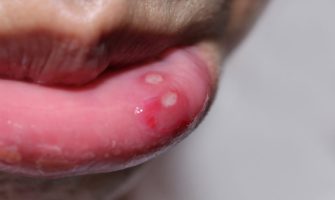Mystery Solved: The Story on Canker Sores

Canker sores are quite literally a sensitive issue, but someone has to talk about it! What are canker sores (or “stomatitis”), why do they appear, and what can be done about them? Anyone who’s ever had mouth sores can attest to the fact that they are just as embarrassing as they are painful, but simply suffering through them does you no good. Get the facts on this common problem to take control of the situation before another outbreak.
How to Tell If It’s a Canker Sore
Because they are similar in name and can appear within fairly close proximity of each other, canker sores are often confused with cold sores. An easy way to tell the difference right off the bat is by checking to see if it’s on the inside or outside of your mouth. Cold sores, which are viral and highly contagious in nature, will appear outside of the mouth, on or close to the lip area. Canker sores, on the other hand, are not contagious and emerge along the insides of your cheeks, gums and the roof of your mouth. If you spot an inflammation with a white center and red border inside your mouth, and it causes sensitivity or soreness when talking or eating, it’s most likely a canker sore.
What Causes Canker Sores
Considering that stomatitis is often chronic, those who experience canker sores due to an injury, or eating something overly acidic, might actually consider themselves lucky. Otherwise, recurring flare-ups can be expected, especially if your case is connected to underlying conditions such as:
|
|
|
|
|
|
|
|
|
|
|
|
It is also worth noting that canker sores tend to be more common in teens, young adults and women.
Ways to Ease the Pain
On average, canker sores usually last between 7 and 10 days. While there is no way to rid yourself of a canker sore once it emerges, there are plenty of things you can do to alleviate the discomfort until it heals, such as:
- Try an over-the-counter gel or painkiller for immediate relief
- Steer clear of spicy, acidic and/or hot foods to avoid aggravating open sores
- Rinse with water or mouthwash regularly to keep the sores free of food particles
- Brush and floss with extra care to prevent unnecessary contact and/or added trauma
Understanding what caused the outbreak can also help you take preventative measures to minimize the chance of future flare-ups. If sores are food or allergy related, for example, simply steering clear of triggers can keep stomatitis at bay.
When Professional Care is Necessary
If painful sores persist past the ten-day period, are over a half-inch wide, and/or are accompanied by other symptoms such as diarrhea, joint pain, rashes or fever, see a dentist as soon as possible. Depending on the severity of your situation, he or she may prescribe medication, surgery, or recommend diagnostic tests. Even if your symptoms are mild, a dental exam can help rule out serious health concerns that could be causing the problem, and give you peace of mind.
Sources:
Canker Sore. (2015, March 19). Retrieved June 1, 2015 from http://www.mayoclinic.org/diseases-conditions/canker-sore/basics/causes/con-20021262
Canker Sores: Causes and Treatments. (2009). Retrieved June 1, 2015 from https://www.deltadentalins.com/oral_health/canker-sores.html